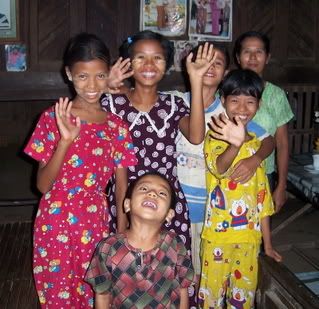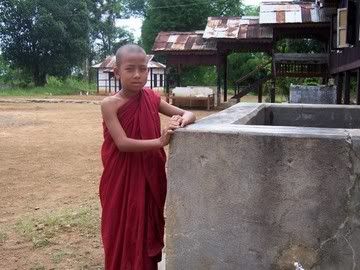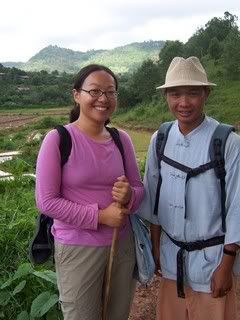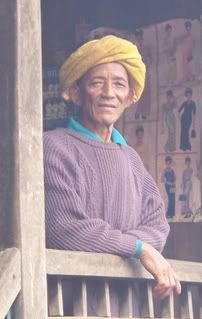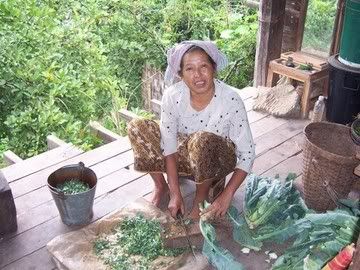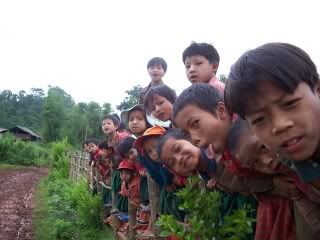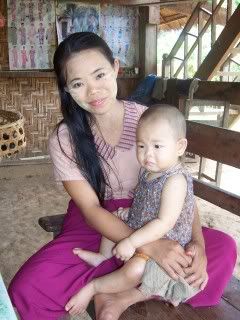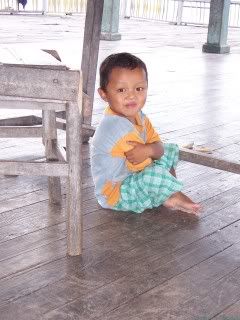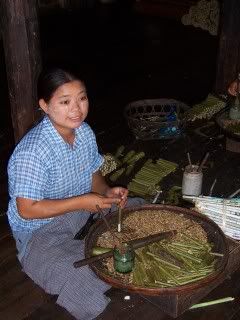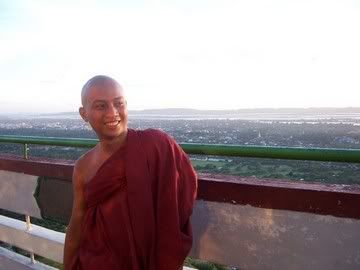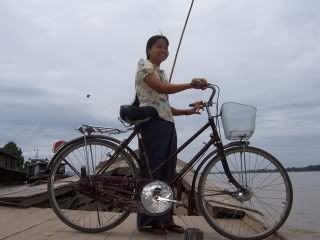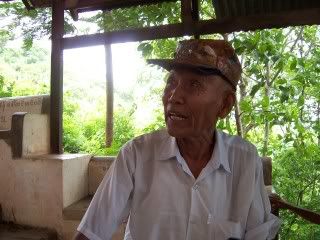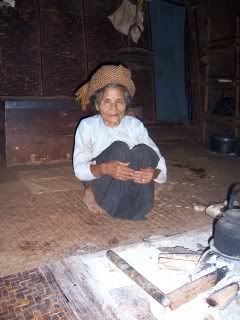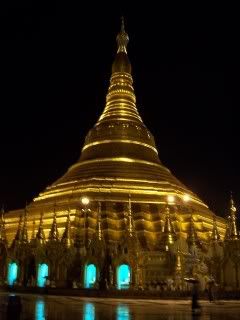
The impressive Shwedagon Pagoda in Yangon (Rangoon) - as iconic in Myanmar as the Eiffel Tower is in France (and the Western world), Shwedagon is just one of many Buddhist shrines in the country. It may, however, be the most beautiful.
After a very long absence, I'm back with a vengeance! And I've saved the best for last. It just wouldn't be right if this blog faded away without any mention of probably my favorite country I visited during the year abroad: Myanmar. Yes, a.k.a. Burma, home to one of the arguably most repressive military regimes in the world, Nobel Peace Prize Laureate
Aung San Suu Kyi, and some of the nicest people on earth.
It seems just like yesterday that I was in Myanmar, but - wow! - it was actually July! Knowing that travel would be a bit slow there and that the country would be unlike any other where I had been before, I planned to milk my 4-week tourist visa for as long as I could. Indeed, I spent 3.5 weeks in Myanmar, and it was a real highlight of my year. Most of the time, it was charming beyond imagination. Only occasionally did enter creepy totalitarianism
à la Orwell's
Nineteen Eighty-Four.

It's always pretty fun to me how staunch, anti-communist militarists usually end up coming back full-circle to full-on commie! This military junta sign is usually found in Burmese, but at many touristy sites you'll see a strategically placed English-language one. This one was directly facing the US Embassy in Yangon. Ooooh, bad move, military dudes! Give this photo a click to see a larger version and read the excellent "edicts" of the crazy military dudes...
A bit of historical background on Myanmar for you: it used to be a British colony, a province of British India known as "Burma". The Burmese gained independence in 1948, largely because of the leadership of General Aung San (Aung San Suu Kyi's dad!). However, Aung San was assassinated by political rivals shortly before independence, and the country has been under military junta rule ever since. Fun fact: at the time of its independence, Myanmar was one of the richest countries (if not the richest?) in Southeast Asia, with ample resources of teak wood, rubies, and jade (all of which it still has a lot of) and called "the ricebowl" of Asia for all the rice it used to export. Not-so-fun fact: today, the country is on the United Nation's list of
Least Developed Countries in the world. I don't think many people dispute that this status is a result of poor governance over the past sixty years.

The current military government has taken over the old government buildings from colonial times. For a regime wanting to throw off the repressive yoke of colonialism, it's quite ironic!
Yeah, so the government is a bit...wacky? In late 2005, General Than Shwe, the head of the military government, consulted with his fortune teller (sigh! Sounds crazy already, doesn't it?) and decided to
move the capital from Yangon (known in British times as Rangoon) to an isolated area of the country. Some say it's because the government also didn't want the US to attack and depose them in Yangon. Whatever. Anyhoo, the new capital, Naypyidaw (formerly Pyinmina, which just might be Burmese for "middle of friggin' nowhere"), is basically in the middle of the jungle. The government is now spending tons of money (that they could use for other development purposes!) to build a capital city from the ground-up. Other wacky fun includes:
(1) The government being able to throw you in jail if you speak out against them! (No
jokes, please...)
(2) Being placed under surveillance if you are a native Myanmar citizen like,
say Aung San Suu Kyi's name (not too much of a stretch here...)!
(3) Being randomly rounded up for forced labor projects!
(Pssst! I encourage you to read more about the country here if you want more details about the political situation of the country, which is quite interesting! Or maybe just interesting to dorks like me...)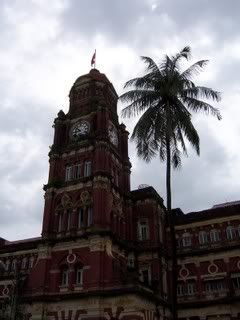
Yangon's own Big Ben. This is the Department of Justice building.
Despite the governmental wackiness, perhaps more than any other country, Myanmar left a real impression on me. At first I didn't want to go, because I didn't want to support the government in any way through tourism. But I managed to go "indie" (i.e. by myself with no organized tour group), so I kept the financial support to the government to a minimum (only at the really big tourist sites, where paying government fees is unavoidable), supported local independent entrepeneurs instead, and had a wonderful time. I had many opportunities to talk with locals, see life beyond the touristy glitz (what the military junta wants you to see as glitz, anyway), and just appreciate how life plugs along under the most undesireable of circumstances. This is why you travel, people! Of potential concern to my mom and dad is that going to Myanmar has left me with an even stronger desire to visit Cuba, Iran, North Korea, Syria, and Libya...but that's another blog, and maybe another lifetime! On with the show!
Just semantics: Is Myanmar or Burma? Is "Myanmar" a noun or adjective?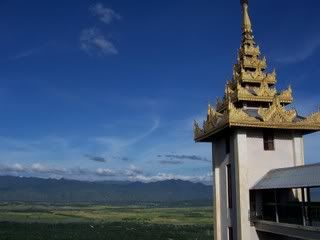
A view from the top of Mandalay Hill.
Yes, very confusing! Is it Myanmar or Burma? What's more politically correct? I've observed that people who say "Burma" are those who associate the name "Myanmar" with the military government, and therefore don't like using the name "Myanmar" because it legitimizes the military junta. However, the name of the country in the local language is, indeed, "Myanmar"! Besides, is calling the place "Burma", a vestige of colonialism that was equally repressive, any better? So I decided to ask the source: Myanmar citizens! Most of them expressed that they preferred "Myanmar" over "Burma" for a few reasons. (1) That's how it's pronounced in their language! and (2) "Burmese" imples only a certain group/tribe of people - the "ruling race" of Myanmar, if you will. Someone said to me that it is not right to classify an entire nation of very diverse tribes and people as "Burmese" in "Burma". As for myself, having previously been one of those "I'm going to call it 'Burma'" people, I decided to switch over to calling the country "Myanmar," out of respect for the nation's diversity, if anything.
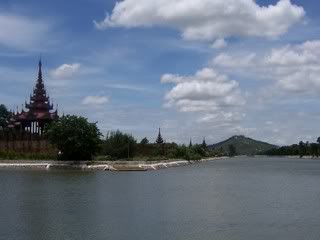
The famous Mandalay Palace (with a view of the famous Mandalay Hill in the background).
The problem, of course, is that "Myanmar" doesn't really lend itself to easy adjective formation (Myanmese? Myanmarish?)! What to do? Why, just use the noun as the adjective! So it's "Myanmar people", "Myanmar food", "Myanmar language", etc. Easy enough, right?
An adventure everytime: Traveling (creeping, really) down and around Myanmar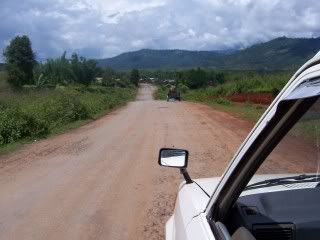
I crossed into Myanmar from China by land, traveling on the famed Burma Road through part of the region known as the Golden Triangle encompassing parts of Southwest China, Laos, Thailand and Myanmar. Opium is an important crop for many farmers here, and trade in heroin (as well as trafficked prostitution and black market goods) is common. Hmm, that explains the multiple military checkpoints during the trip!
Transportation logistics in Myanmar are not easy. Sometimes, you really
are better off walking (See "Life outside the city: A trek through Shan country" below)! The transportation infrastructure is poor, and paved roads that do exist are often not well-maintained. Still, it's not impossible to get around. But you might have to get creative sometimes. And, truly, patience is a necessary virtue!
Buses get canceled regularly, especially if they can't fill the seats. I waited by the roadside for a bus in an attempt to get to a remote part of Myanmar called Namhsan...but I finally threw in the towel after a few hours of solitariness at the side fo the road.
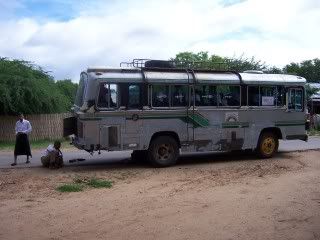
You wouldn't have properly traveled in Myanmar if your bus didn't break down...for hours at a time. Wheeeee!
But I'm not sure if hopping on a bus is necessarily helpful either, especially since the vehicles in Myanmar tend to be old as Father Time and break down quite frequently. On my way to Kalaw, I was delayed about 6 hours because the bus just broke down in the middle of nowhere. The driver and his assistant announced that they were going to the next biggest town to get some new parts of the bus, and just disappeared! Ah! Well, at least they came back. :)
On the bright side, it's all a big adventure! It's also pretty amusing that the steering wheel is on the right side (like in England), but the cars still drive on the right side (just like in America!). It feels a bit weird.
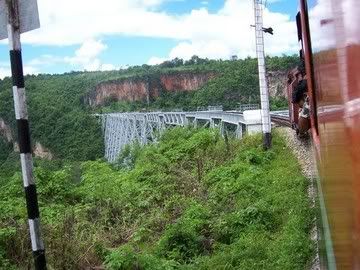
Riding on a train that hasn't been updated much since British colonial rule - cool! Riding over a 800 foot-high viaduct that hasn't been radically updated since its construction in the 1930s on a train that might derail - a bit nerve-wracking! Sure enough, the train crept over the viaduct at a speed of about 2 miles per hour (OK, I'm exagerrating...but just barely!). The adventure (and long ride) was certainly worth the ride!
I also got to ride on some old locomotives that haven't really been updated since the British left! On my way from Hsipaw to Pyin U Lwin, I rode in the "common class" of the train with the locals, and it was lots of fun to be stuffed in with baskets of fruit and other groups being brought to market. Those trains really
creep, though, and it's a bumpy ride! It would have taken 2 hours to drive to Pyin U Lwin from Hsipaw...instead it took about 7 hours on the train. I guess I should have been afraid of derailing, but I was having too much fun. :)
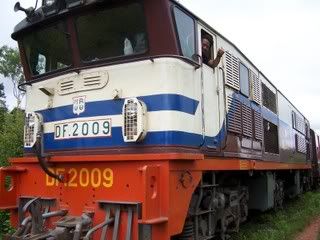
More trains! I love the guy waving to me from the window...
Other clever ways of getting around included oxcarts, horse carts (I discovered I'm allergic, though...boo!), and good ol' trishaws. Trishaws are basically bikes with a seat attached to the side. They're great, and the drivers are friendly and fun. My favorite people are probably the trishaw drivers of Mandalay. What a bunch of guys!
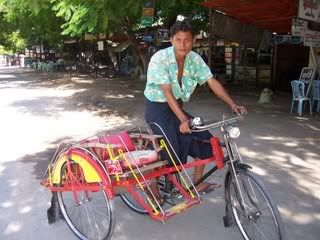
Mr. Chit Koko and his trusty trishaw in Mandalay.
In Mandalay, the trishaw drivers work 12+ hours a day, and many of them have picked up
very good English (better than students who pay for classes!) just in their interaction with foreign tourists. They work really hard and are always continually improving their English and learning more about the local sites so that they can act as de facto tour guides for the foreign tourists (otherwise, you need to pay large fees and undergo expensive training to be a licensed as an "official" tour guide with the government). They are working towards bettering life for themselves and their families, and you gotta respect that! During my time in Mandalay, I stuck with two trusty trishaw men - Mr. Chit Koko, who looked like a kind of hardened street dude, but was really the nicest guy ever, and Kyaw Kyaw (believe it or not, this is pronounced like "Joe Joe"!), who was 17 years and had been working as a driver for 2 years in order to support his parents and little brother. Two really great people. If you're ever in Mandalay, look them up (really! they're always in the same spot and take referrals!)!
Myanmar Moolah
The old kyat notes that were discontinued some time ago all had portraits of national hero Aung San on them. It is said that the notes were taken out of circulation for a few reasons: maybe the government didn't want Aung San's portrait reminding Myanmar people of his daughter, Aung San Suu Kyi. Some say the ruling General's fortune teller told him the denomination of the notes were in an unlucky number. Then again, maybe it was the hyperinflation. In Myanmar, anything is possible!
They're
kyats. That's pronouced "chat", not "ky-at" (crazy Sino-Tibetan languages!). At the time I was in Myanmar, a good exchange rate was about US$1 to 1200-1300
kyat. Considering you could get a nice meal for under 1000
kyat, this wasn't too bad!
The first thing you should know about Myanmar is that (unlike other countries), you never ever
ever change money officially in a bank or currency exchange. You will get about 500
kyat for US$1, as the military government takes a big juicy cut and you want to avoid supporting those dudes whenever possible! So...what to do? Change your moola in the street! Usually, it's pretty easy - the moneychangers will find you (hmm, I guess I don't look "Myanmar" enough...). Yeah, it's pretty shady handing over money to strangers and then having them give you a big stack of bills back, but people I dealt with in the moneychanging business weren't shady at all. In most cases, they let me take the
kyat with me to a private place, let me count it, and
then let me give them the US dollars. That's pretty trustworthy! Added plus is that private moneychaing helps the locals more and you benefit from not being ripped off. PLUS, you feel like a real baller with that fat wad of cash in your pocket.
Second thing you should know about Myanmar: leave your credit cards and travelers checks at home. They just don't work here. That's what it means to be a pariah state and have all the major Western banks and corporations not affilate with your country! I think there might be one Singporean-run hotel in Mandalay that accepts credit card, but that's because they have off-shore processing and also charge you a spiffy 20% fee or something. So it's all about carrying large chunks of US dollars during your trip! Luckily, no one will rob you (see "Religion" below).
Language fun: Adventures in Burmese and (Idiomatic) English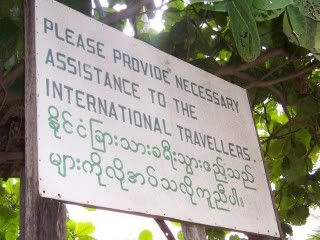
Having arrived in Myanmar without speaking a lick of Burmese, I was very, very appreciative for this sign in Hsipaw.
Besides Ghana (where most people spoke English and my most excellent guides/friends, Yinka and Calvin, provided superb translation), Myanmar was the first big country where I did not speak the local language, Burmese. Officially, the language is called "Myanmar" or "Myanmar language", but a lot of people still say "Burmese".
Indeed, once I hit Southeast Asia, my foreign language brain really just
shut down. I'd like to say that Burmese (the
official language of Myanmar) was just really hard (it was! Crazy southeast Asian pronounciations...DAMN YOU!), but they do have an alphabet so who am I to talk? It was so hard for me just to learn the basic phrases of Burmese.
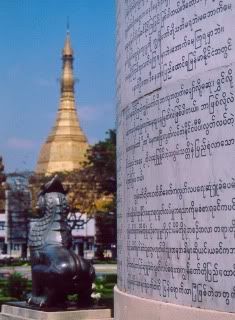
True, Burmese at least has an alphabet, but that doesn't mean it's easy to pronounce or read! Here, a tablet at Sule Pagoda in Yangon. Cool picture, eh? Photo cred to Globe trotter Ted Chang.
Luckily, as a former British colony, a lot of Myanmar people (particularly people who are 50 years old and up) speak excellent English. And with that quaint Queen's British accent, too! Unfortunately, the military government allowed the schools to go to shit, and a lot of the younger generation don't speak English too well (if at all). There is, however, still a really high demand for English language instruction. In fact, in Mandalay, I befriended a bunch of locals who ran an English school in order to fund the Myanmar puppet theater! I was officially invited to be a guest speaker in their classes! It was a lot of fun. I just stood in front of the classroom and talked about America to a room full of Myanmar youth (ages 14-25). They were really fun and completely intrigued by my odd American accent. I had a question-and-answer session, and it was really amusing. The kids were very shy, but some managed to ask all sorts of great questions. My favorite was "What is the meaning of life?" (I made something up)
One funny bit about Myanmar English speakers - young and old - is that they absolutely
love idioms! In the class where I "lectured", the kids were using a book called "American Idiomatic English." Dang, let me tell you - American English is really impossible to learn with all those darn idioms! I mean, think about it, if you were learning another language and people referred to "being loaded" and "broke" as references to money, wouldn't you be confused? In any case, many of the Myanmar people whom I chatted with or befriended loved peppering their speech with idioms and slang. It sounded a bit silly at times, but it was very cute. I got a lot of "See you later, alligator!" In order to contribute a little something to their cultural education, I also taughted them a few new words here and there ("cool", "rad", "awesome", "dope", "wicked").
I'm hoping that English education can really improve in Myanmar. In fact, it is really one of the big assets that the country has, and the young people there are very eager to learn (and pretty darn good at self-teaching themselves, from what I saw). I think it will come in very handy when (and if?) the military government dissolves and the economy liberalizes. If the society is educated and can speak English, that is the first step towards success (much like India). Fingers crossed!
Dress and Customs: Whoa, are guys wearing skirts? Why's your face all yellow? Why are your teeth red and nasty? And why am I grabbing my elbow all the time?!?!The first thing you might ask yourself in Myanmar is, "Hey, why are the dudes wearing skirts?" Myanmar is one of the few places left in Southeast Asia where traditional dress is still a part of everyday life. Both men and women wear the traditional
longyi, which is a long sarong. Men knot it in the front, while women sort of wrap it around their waist. You can really make a fashion statement with those things! And weaving the cloth can be quite the art. There are plenty of weavers and
longyi shops in big towns, and some of the nice ones are just lovely! Of course, I couldn't resist buying one while I was there (even though I'll probably never wear it).

In addition to moisturizer and sunscreen, thanaka paste is also used to draw cute designs on faces. In this way, it's actually a bit like makeup. The "circle on each cheek" design is quite popular. This little girl's thanaka was really nice, so (after buying a hat from her to protect myself from the sun, since I didn't have any thanaka) I asked to take her picture.
Walking around the first few days is also quite disconcerting because you'll see people (usually women and kids) with yellow paste smeared all over their faces and arms! At first, you'll think this crazy clown show is getting out of hand, but then you realize the paste is just
thanaka, a sunscreen/moisturizer made from tree bark. Seeing girls draw the thanaka in cute shapes on their faces also makes you realize it's like make-up. Really cute! And who am I to criticize tried-and-true beauty regimes?
Red teeth = betel. It's really a testament to the heavy Indian influences in Myanmar culture, but, my goodness, that stuff is nasty. It makes smoking look good. Basically, "betel" as I knew it was a red, limey paste wrapped in fresh betel leaves, placed in the mouth, and chewed for a mild stimulant effect. You spit out the juice and saliva that builds up from chewing. Everywhere you'll see puddles of red spit and red, betel-stained teeth. Mmmmm, pretty!
One of the Myanmar customs/traditions that I quite like is the "holding-your-right-elbow-with-your-left-hand" custom when you give and receive things. It's really a respectful way exchanging things (like using two hands in Chinese custom when presenting things to elders), and I just love it. It becomes automatic after a while...and, in fact, I still find myself doing it from time to time here in America. Weird!
Food & Drink: Mmmm....greasy curry and tea shops
The traditional Myanmar meal comes with a main dish curry, (lots of) rice, soup, and more side dishes than you can shake a stick at. This is a gentrified version (less greasy curry, less side dishes) that I had in a fancier restaurant in Mandalay, but it was one of the best meals I had in Myanmar. Note the presence of my favorite drink discovery of my travels: fresh lime juice!
I liked Myanmar food. But, coming from me, that's like saying, "Yeah, I breathe air", so let me elaborate a bit more...
Typical Myanmar food is centered around curry (Indian influences again!), but fear not non-spicy food lovers, Myanmar curry is not spicy at all. It's flavorful and tasty. What's not so nice is that there is usually a big slick of oil floating on top that you have to scoop away before eating. This is because most curries are prepared fresh for lunch, but it tends to sit around while the customers float in. The layer of oil apparently keeps flies away. Hmmm...good idea (I guess)!
When you walk into a Myanmar food restaurant, you'll ask for a curry of your choice, and you'll automatically get rice, soup, and a TON of side dishes with it. Super tasty...and all for around 800-1000
kyat (US$0.70-0.90). Wash it down with a Star Cola or Crusher orange soda (Pepsi and Coke don't operate in Myanmar, you see...), and it's a filling meal that'll last you all day!
In between your filling Myanmar meals, you can also grab snacks at the local tea shop. Tea shops were one of my favorite aspects of Myanmar life. They are everywhere, a center of social life in Myanmar and characterized by low tables and small, kid-sized stools. I would love ordering a tea (sweetened with condensed milk, of course!) and a snack (maybe a samosa or a sweet treat...mmm, Burmese banana pancakes!) and just chilling out while absorbing the local atmosphere. A lot of the "waiters" in the tea shops were young boys who are probably not subject to the fairest of labor conditions, but they were sweet and always very helpful (especially in light of my lack of language skills). I always left a well-deserved tip (not difficult to leave when your tea and snack cost about US$0.10-0.25 total).
Religion: Monks, Buddhas, and Pagodas aplenty (and maybe a Jumping Cat or two...)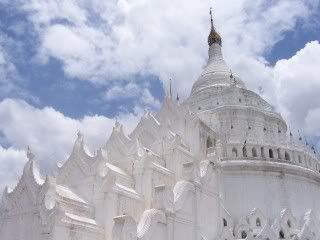
A temple in Mingun, and probably one of the most beautiful ones I saw during my time in Myanmar (you can only be impressed by so many golden stupas, you see...). I think it was one of the nicest visual memories I had of my trip...and there were quite a few, dontcha know?
Buddhism reigns supreme in Myanmar. Over 80% of the people are Buddhist, and most of them actually practice their religion. In my humble opinion, I always feel that the big difference between most Western and Eastern religion is that the latter is more often adopted as a true lifestyle and personal philosophy. So the fact that the country is predominantly Buddhist and largely still untainted (for lack of a better word!) by the excesses of modernity is a reason that people give for the relative safety of the country. I never felt unsafe in Myanmar at all. I just had to count on the fact that Myanmar people didn't want to come back as cockroaches in their next life. :)

Just outside of Mandalay, Amarapura is famous for a really really long teak bridge and the daily alms to monks. As a predominantly Buddhist culture, giving alms to monks is quite common (in fact, a lot of "monks" are really just fakin' to get alms and dupe foreigners). However, at Amarapura, a "donor" funds the morning meal of monks and TONS of them line up at the monastery, which is one of the biggest in Myanmar! I've never seen so many monks in one place in my life!
Everywhere you go, you'll see monks - young and old - shaved and clad in saffron and yellow robes. In fact, every boy undergoes novitiate training for a short time (usually during summer vacation or some other long holiday) at their local monastery. This is because only men are allowed to interact with monks (fun fact!). So the boys learn the basics of the
Bali language (for chanting and prayers), how to interact with priests, etc., and become the representative of their families in the monasteries. A lot of boys also tend to stay on for training as monks.
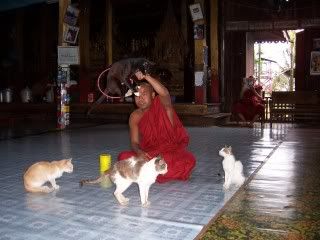
The "Jumping Cat" Monastery at Inle Lake is famous for just that...jumping cats! It's crazy! Maybe a life of devotion is a bit boring sometimes...so boring that you might resort to training cats to jump through hoops.
Yes, there are also nuns. They also shave their heads and are usually clad in pink, but women are not afforded the same status as men in Buddhism, so it is not as prestigious to be nun (and certainly not required).

What luck! A big ol' convoy of nuns in front of Mandalay Palace!
There are also lots of temples, pagodas, and Buddhas around. And I mean
lots. Buddhists show their devotion by building temples, donating Buddha statues, applying gold-leaf and jewels to said temples and Buddhas, and the like. So in a religious country like Myanmar, you've got no shortage of displays of devotion! In fact, Shwedagon Pagoda (pictured at the beginning of this blog post) is covered in literally
tons of gold. At the top of the monument are 5,448 small diamonds, 2,317 rubies, and a 76 carat (15 g) diamond!
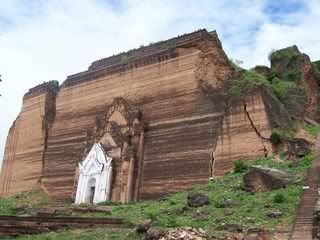
Just outside of Mandalay, in the town of Mingun, is the largest Buddhist temple in the world...or, rather, what would've been the largest one in the world. An earthquake halted construction in the 1790s, so now it's just a pile of rocks. But, as a would-be Buddhist temple, you've still got to take off your shoes out of respect if you want to climb it. What's a bunch of sharp, hot rocks in the way of a good view from the top? No problem, I say! My feet did hurt quite a bit during the climb, though...
Travel tip: when going to Buddhist temples, skip the socks and shoes and stick with sandals. That's because you must take off all footwear when entering a Buddhist temple. This means a lot of walking on hot outdoor pavements, restrooms (squat toilets!) onsite, and even the
ruins of holy Buddhist sites. No one cares about you hurting your delicate feet here, buddy! Luckily, most sites are really clean (squat toilets included!), so don't worry about stepping in too many surprises. There's nothing you can do about pointy, sharp rocks, though...
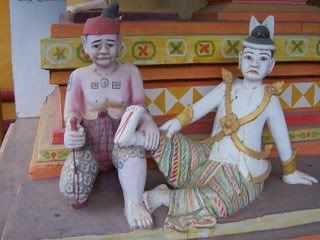
Maybe this is punishment is what happens if you wear shoes into a Buddhist temple...
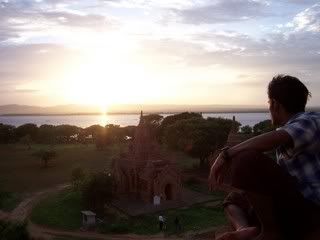
Watching the sun set over the Ayerwaddy River with locals.
The temples of Bagan are often compared to Cambodia's Angkor temples. Back in the day (maybe 1,000 years ago?), a few ancient Burmese kings decided it would be a good idea to build a helluva lotta temples on the river plain of the Ayerwaddy River. There still about (more than?) 2,000 temples standing, all concentrated in a 40-square kilometer area! It's pretty cool. I was able to combine my two travel passions of temple climbing and sunset chasing over my few days in Bagan. It was also the low season, so I didn't really have to climb over people (
not a travel passion of mine).
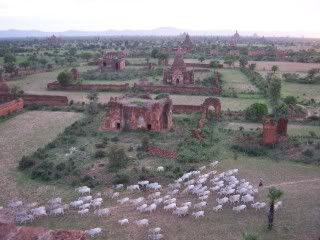
From the tops of one of the many temples of Bagan, I chased sunsets, scoped out the flocks of sheep grazing as well as the many other temples in the complex.
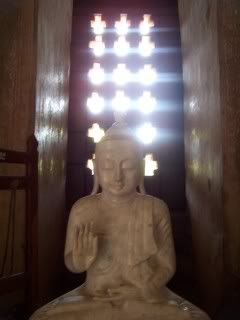
Buddhas...Bagan style!
I heard from one of my guides that the idea behind the presence of so many Buddha statues in Myanmar is that, as long as Buddha has his eye on you, you're bound to behave well! Hmm, that explains a lot...
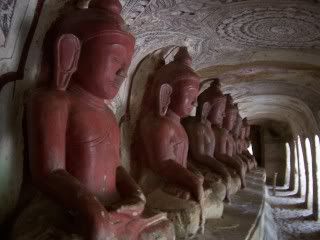
In Monywa, there is many a Buddha statue to be seen and admired. Here's just a sampling!
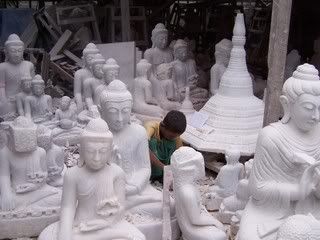
And they just can't stop making the Buddhas!
Life outside the city: A trek through Shan countryAt the suggestion of some friends who had been to Myanmar before, I decided to take to the hills! I arrived in the sleepy town of Kalaw (after the 6-hour broken-down bus incident) and proceeded to track down my recommended guide, Mr. Tun Ti, who took foreigners on 3-day treks through the hilly Shan countryside and villages to Inle Lake - one of the major tourist attractions of Myanmar- 60 kilometers (just under 40 miles) away. Mr. Tun Ti came highly recommended because he would take alternate, less-traveled routes that would give trekkers a better sense of village life. He also spoke 5 of the local dialects, so I figured he would be a good guy to guide me.
The problem, of course, was that I couldn't find him! My friend who had recommended Mr. Tun Ti had forgotten his name, so I was vaguely describing some guy who led treks, spoke 5 local dialects, and whose father-in-law owned a restaurant to anyone who could've helped me. Kalaw is a sleepy town, and there are only so many trekking guides (and restaurants), but I was getting discouraged. I guess it didn't help that other guides wanted my business (it was the off-season!) and wouldn't tell me where to find him. So, too discouraged to look any further, I wandered into a small storefront advertising trekking to Inle Lake, convinced that I would have to settle for someone not as good. I started chatting with a guide in that trekking outfit...and discovered I was actually talking to Mr. Tun Ti himself! I recruited a fellow traveler (Anne from Germany) to go with me so that Mr. Tun Ti could personally guide us (he was very responsible in telling me that if I went hiking alone, he could not take me, since a man guiding a young girl solo would look not so great!).
So I got lucky! And the trek was just awesome. We walked from about 8 AM to 5 PM everyday for 3 days through the countryside, and it was lovely and wonderfully relaxing. There's nothing like walking for miles and miles everyday! The entire trek took three days, and we stayed in a local home the first night, a monastery the next. We also stopped by local villagers homes along the way, both for lunch and so that Mr. Tun Ti could check up on friends and check in with village elders to see how the village was doing. I got a wonderful insight on some of the different minority tribes of Myanmar and village life, from both Mr. Tun Ti and local Myanmar people themselves. I'll never forget the experience.
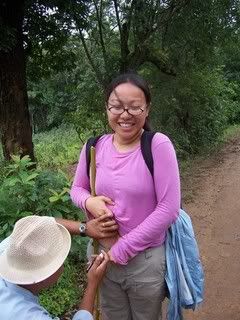
One silly bit of the trip: my experience with leeches (it was rainy season, after all)! Just one leech, really...which managed to crawl into my bellybutton! I must have brushed up against a tree and it somehow attached itself to me (it was a tree leech, I learned...black in color and not brown like the ones in the mud). I felt a sharp pinch in my bellybutton and looked down to see something black and wormy disappearing into the deep crevices of my navel! In this shot, Mr. Tun Ti, is actually just looking for the sucker. Mr. Leechy actually went so deep that we could no longer see it! If we couldn't see it, we couldn't pick it out. All I could do was wait for it to feed, get fat, and then have Mr. Tun Ti pick it out if he could see it. I probably should've been freaked out, but I kept giggling throughout the whole experience. Apparently, nothing like it (leech in the navel) had ever been heard of...neither by Mr. Tun Ti nor villagers, who deal with leeches every day. I just kept thinking about how my mom used to tell me that my bellybutton was just a hole into my body where cold air could enter - good thing we got that leech out before it got inside my organs! Hee!
Other than that, some pictures from village life...
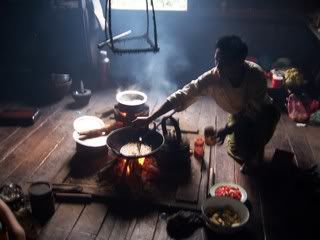
We were treated to many delicious meals prepared in village kitchens.

With the lack of paved roads or cars in the Shan hills, sometimes the good ol' oxcart is the best mode of transport!
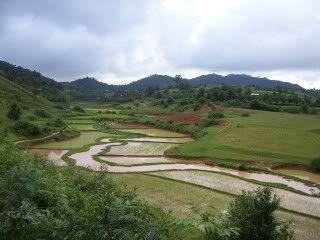
Just one of the many rice paddies I trekked through/by during my foot journey through the Shan mountains. I just couldn't get enough of 'em!

Villagers from the Pa-Oh hill tribe hard at work in the paddies.

During my three-day trek through the Shan mountains, I passed through a village where the land is not so amenable to farming. As such, the villagers weave bamboo baskets to sell to local farmers and merchants. The villagers do everything from grow the bamboo, cut the bark into strips, weave the baskets, to bringing the finished product to the distant markets by foot (good thing these suckers are relatively light). The baskets are sold for about 600 kyat (a bit less than US$0.50) each.
Inle Lake: Life floats along...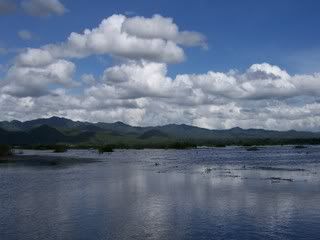
Inle Lake is shallow, but huge. It is surrounded by the hills of the Shan countryside and looks like a sheet of glass on a calm day.
My trek led me to
Inle Lake, which is quite literally a floating world unto itself. Everything from villages, temples, and gardens float here...or are propped up on stilts. You even have to row to your neighbor's house, as land is a rare commodity! But this has also created a unique society (and tourist attraction) where life floats on and people row on (with their legs!).
A few images below...

Boats are the main mode of transportation at Inle Lake, where communities thrive among floating villages and gardens nestled within the Shan mountains. This was the boat "parking lot" outside one of the markets at the lake.
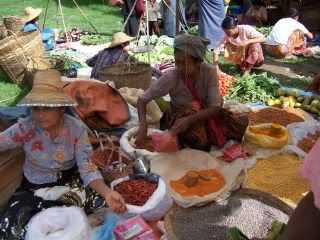
Markets take place on a rotating weekly schedule at Inle Lake - a market takes place in a different village (the ones on land!) each day. Villagers from local hill tribes come to market to sell and buy goods, which can be produce, tea, crafts, etc.
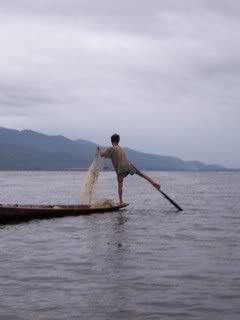
The fishermen of Inle Lake developed a special rowing technique in which they stand on the bow of their boats and row with their legs...I mean, oars...oh, whatever, it looks like this! It leaves their hands free to handle fishing nets. Cool, eh? Of course, just as I was getting really close for some good photo ops, my camera died. Argh, I hate you Kodak!
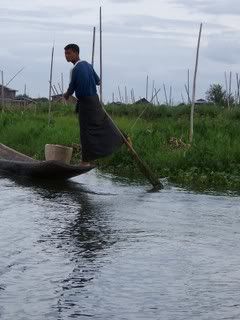
More leg-rowing...and longyis!
Life goes on...
Myanmar people who live in places where travelers may go do the best they can by selling the usual touristy knick knacks. The colorful sculptures and puppets at market were always nice to browse.
In the West, the government of Myanmar is (rightly!) villanized to the point of parody. Yes, they're repressive and creepy. As people fortunate enough to live in a functioning democracy where we take a lot of our freedoms for granted, it may be hard for us Americans to believe that life would be bearable under a government so corrupt, repressive and, well,
shitty. The most naive of us might believe that Myanmar people sit around all day moping about how horrible their lives are, but this definitely isn't the case. Seeing how Myanmar people go about their daily lives is both inspiring and sad at the same time. People really plug along with their daily routines, trying to do the best they can for themselves and their families.
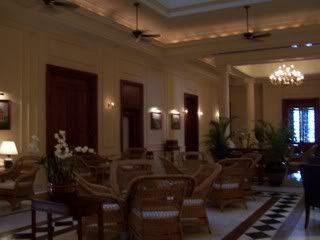
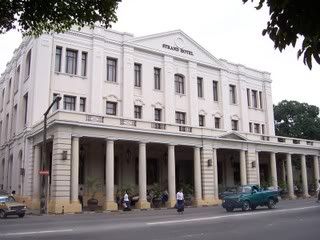
The famous and beautiful Strand Hotel in Yangon. Inside and out, it demonstrates a little bit of what it must have felt like to be an white colonial dude back in the day (for the bargain price of US$450-900 per night).
Most people cherish the opportunity to interact with foreigners. There is a genuine innocence and curiosity about the people of Myanmar that you cannot find in many places in the world today. It is sweet and absolutely charming. A vast majority of the people that I was lucky enough to meet and befriend are very good, honest, hardworking, and trusting people. Some people say that Myanmar is what Thailand must have been like 50 years ago, before western tourism made much of it into a capitalistic hellhole of a tourist trap (OK, that is harsh, but that's the general sentiment about Thailand!). After being cautious around people all year (having my camera stolen in China didn't help!) and all my life (I blame American cynicism!), this was refreshing. Pardon my corniness, but it really restored my faith in mankind!
So why is it sad? The very fact that they plug along almost apathetically to their political situation is a result of how hopeless alot of them regard their political reality. It's nice that Myanmar people can retain a very wry sense of humor despite it all (one joke: in Myanmar, blackouts even in the big cities like Yangon, are common occurrences everyday. The state-run newspapers, on the other hand, always show the military generals touring new electricity plants. The locals joke that you would probably get shocked touching the newspapers instead of an electric outlet, since there is apparently more electricity in the papers than in the cities!). Still, the most that people can do to express their feelings about their political and social position is to smile and shrug, and go on doing what they're doing to survive, whether that is leading a trek for tourists or driving a trishaw for 12+ hours a day. It's quite a bittersweet, melancholy existence. Maybe that's all that life is about, but it should be worth more, shouldn't it? I think I have a better sense of life, living, and appreciation after my trip. So for that, I thank the fine people of Myanmar.
Ce zu beh, Myanmar!
